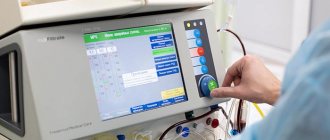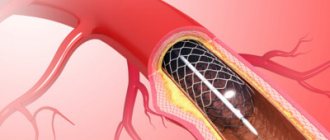Doctors' actions
Resuscitation for a heart attack involves intensive therapy aimed at maintaining basic vital functions and stabilizing the condition. To achieve results, certain prohibitions and recommendations are introduced. This:
- exclusion of physical activity;
- preventing the patient from contacting friends and relatives;
- strict adherence to bed rest;
- 24-hour monitoring by doctors;
- regular examination.
In case of cardiac arrest, cardiopulmonary resuscitation methods are used. You cannot spend time with them, so it is advisable that people nearby provide assistance (indirect cardiac massage and artificial respiration) to the patient. The arriving team of specialists will continue manipulations to preserve vital functions, preventing the death of brain cells. This condition occurs due to the cessation of cardiac function and respiratory function against the background of extensive necrotic lesions. The duration of resuscitation is usually approximately half an hour. The patient's chance of survival increases significantly when assistance is provided in the first five minutes after the attack.
The actions of doctors directly depend on the severity of the lesions, so the diagnosis is carried out:
- Magnetic resonance imaging;
- electrocardiography;
- cardiac catheterization;
- echocardiography;
- lab tests.
Based on its results, it will become clear what to do in intensive care during a heart attack. In most cases, the patient is prescribed intravenous medications to stabilize the heart, prevent the formation of blood clots and dilute them. In severe cases, surgery is recommended:
- stenting;
- coronary artery bypass grafting;
- excision of aneurysm;
- installation of an artificial pacemaker.
Patient observation
One of the monitoring tools is a mini-defibrillator, but, of course, it is not required for everyone to install it.
Equipped with multiple electrodes, it allows you to record your heart rate. At the slightest warning sign, it sends a small electrical discharge into the muscle. A patient diagnosed by an ambulance with acute coronary syndrome is immediately taken to the intensive care unit. Often, large cardiology clinics have separate specialized infarction intensive care units.
Resuscitation during a heart attack primarily consists of providing the damaged heart muscle with oxygen, stopping the developed life-threatening arrhythmias, and correcting hemodynamic disorders and thrombus formation.
To do this, the following procedures are used:
- oxygen therapy - the patient is connected to a ventilator to combat hypoxia;
- infusion therapy - indicated to restore normal blood supply to tissues, water and electrolyte balance, and is used to provide parenteral (intravenous) nutrition;
- sedation – during a heart attack it is very important to calm the patient’s nervous system, for which appropriate medications are used;
- pain relief – ischemia of the heart muscle is accompanied by intense pain, which can lead to the development of shock, so it is relieved with the help of narcotic analgesics;
- prevention of thrombus formation or dissolution of a formed thrombus - it is very important to prevent a recurrent attack or to ensure access of oxygen to the ischemic area, for which anticoagulants such as heparin or warfarin are prescribed;
- strict bed rest is necessary to minimize physical activity and restore the body.
While in intensive care, the patient can be treated surgically:
stenting of coronary arteries;- coronary artery bypass grafting;
- laser angioplasty;
- balloon dilatation of coronary vessels.
Patients are in intensive care after a heart attack under constant supervision of medical personnel. They are connected to equipment around the clock, which automatically takes an ECG, monitors blood pressure, respiration, heartbeat and other indicators. If the patient develops clinical death, he is urgently given cardiopulmonary resuscitation, which consists of the following actions:
- indirect cardiac massage;
- artificial ventilation;
- defibrillation;
- drug support for the patient.
How long do they stay in intensive care after a heart attack?
The duration of the course of therapy in a hospital setting depends on the patient’s condition, the speed of his recovery and the presence of complications. It can be divided into the following stages:
- The acute stage begins from the moment of the first manifestations of the attack and lasts for 2 weeks. The patient is hospitalized for resuscitation. Towards the end of this stage, he is transferred to the ward of the cardiology department.
- The subacute stage lasts approximately 3-4 weeks. The patient will have to stay in the hospital for this period to avoid complications and improve the condition.
No one will be kept in the clinic by force, but if you leave its walls on your own, doctors relieve themselves of all responsibility for the patient’s life. This is due to the high probability of developing thromboembolism and other consequences of a heart attack. If the patient gets better earlier than expected, then there is a chance of discharge in 2-3 weeks. Next comes the rehabilitation stage, during which the patient will have to follow the recommendations of specialists and be periodically examined. Typically, recovery takes no more than 1 year.
After discharge
At home, a person who has survived a myocardial infarction will have to take medications every day designed to combat complications and reduce the load on the heart muscle. Tablets are commonly used to prevent blood clots (Aspirin) and to reduce myocardial oxygen demand (beta-adrenergic blockers) and cholesterol levels (statins). It is equally important to introduce certain restrictions:
- take breaks while working;
- adjust your diet;
- reduce physical activity;
- to refuse from bad habits;
- get enough sleep (7-8 hours a day).
The person will have to be examined periodically for a year after being discharged from the hospital. Based on the results obtained, the doctor will be able to monitor the speed of recovery.
Secondary prevention
The development of a heart attack indicates a worsening of coronary artery disease. After experiencing an attack, problems with blood pressure and heart rate rapidly develop, against the background of which signs of heart failure arise. To avoid the development of consequences, you will have to follow the rules of secondary prevention:
- attend cardiac rehabilitation classes;
- follow a strict diet;
- follow the treatment plan drawn up by the doctor;
- monitor pulse and blood pressure;
- follow the rules of a healthy lifestyle.
Deceptive Forms
There are: special forms, abdominal:
- with epigastric pain (in the abdomen);
- sweating;
- malaise;
- psychological forms - disorientation, fever;
- belching;
- limited by depressed breathing (unexplained acute shortness of breath);
- cardiogenic shocks, during which pulse and blood pressure change;
- heart rhythm disturbances (palpitations, malaise);
- fever.
Fever in a man
In women, the main symptoms are also atypical:
- feeling tired;
- shortness of breath on exertion;
- abdominal discomfort.
In all of these asymptomatic or misleading presentations in women and men who have at least one cardiovascular risk factor:
- tobacco;
- diabetes;
- passive lifestyle;
- high blood pressure;
- cholesterol;
- stress, etc.
Stress
An electrocardiogram (ECG) should be performed to confirm or reject the diagnosis of myocardial infarction.
Features of caring for people who have had a heart attack
Positive statistics can be an incentive for the patient. With proper care at home, the likelihood of developing complications is significantly reduced. Recommendations compiled by experts will help with this:
- Close people need to protect the patient from stress and physical work. You need to spend more time with him and walk in the fresh air more often to help him return to his previous life.
- Intestinal problems occur more often in the acute stage due to the patient’s low mobility, but sometimes continue after discharge. The patient will have to take pills prescribed by the doctor (laxatives, painkillers) to reduce the degree of discomfort and tension. Additionally, you can do a cleansing enema.
- Elderly people should be constantly monitored. They may forget to take the drug or not engage in strenuous physical activity, which increases the likelihood of complications.
Diet planning
A properly formulated diet will prevent the development of atherosclerosis. It is the main causative factor of myocardial infarction. To avoid the formation of fatty plaques that clog blood vessels, it is necessary to reduce cholesterol levels by limiting and increasing the amount of certain foods in the diet:
| Limit | Increase |
| • Food containing a lot of calories. • Alcohol. • Salt (no more than 5 g per day). • Fatty foods, fast food. | • Vegetables and fruits (150-200 g every day, divided into several meals). • Lean meat and fish. • Fermented milk products (low fat). • Bread (from wholemeal flour). |
Thanks to fish in the diet, the likelihood of death from cardiac ischemia is significantly reduced. Pressure stabilization occurs after reducing the amount of salt used. Experts also advise reducing the consumption of saturated fatty acids (marginal) in favor of unsaturated (unsaturated) fatty acids, divided into the following types:
| View | Products |
| Monounsaturated acids | Olive and rapeseed oil, avocado, almonds, pistachios. |
| Polyunsaturated acids | Vegetable oils (canola, soybean, sunflower), fish and seafood, leafy vegetables and pumpkin, poppy, flax seeds. |
Unsaturated fatty acids help reduce bad cholesterol (high density) and increase good cholesterol (low density). Their amount in the diet of a person who has survived a heart attack should be 10 times greater than limiting acids. In total, it is allowed to consume no more than 100-150 g of fat per day.
A person should get approximately half of their calories from carbohydrates. The remaining amount must be replenished by digesting proteins and fats. Simple carbohydrates (confectionery, processed cereals, sweet sodas) should be excluded from the daily menu. You can replace them with complex carbohydrates containing large amounts of fiber (vegetables, fruits, cereals).
Drug therapy at home
While at home, a person will have to follow a drug therapy regimen drawn up by a specialist for a long time:
- Statins (Atomax, Crestor) are prescribed to reduce inflammation in blood vessels and the concentration of bad cholesterol in the blood. This effect helps prevent the formation of fatty plaques. They must be taken while following a diet.
- Antiplatelet agents (Aspirin, Aklotin) prevent blood clotting by reducing its viscosity. Taking them significantly reduces the likelihood of blood clots.
- Sartans (Losartan, Valsartan) and ACE inhibitors (Captopril, Quinapril) prevent angiotensin II from exerting its effect, which makes it possible to stabilize blood pressure and heart rate
- Nitrates (“Nitroglycerin”, “Nitrocor”) are used to quickly dilate blood vessels, relieve hypertension and relieve pain. They reduce the load on the heart and improve its nutrition.
- Beta-adrenergic receptor blockers (Anaprilin, Timolol) prevent adrenaline from exerting its effect on the heart muscle. With long-term use, it is possible to reduce the frequency and severity of heartbeats, reduce blood pressure and reduce the myocardial need for oxygen.
- Tablets rich in magnesium and potassium (Orokomag, Magnestad) are necessary to improve heart regulation, stabilize neuromuscular transmission and maintain normal vascular tone.
Lifestyle correction
To avoid relapses and complications of a heart attack, the patient will have to reconsider his lifestyle and make certain adjustments:
- Physical activity should be completely avoided in the acute phase so that the heart does not become overstrained. After transfer to the cardiology department, doctors will recommend doing simple movements to maintain the necessary tone. Gradually, the patient will be able to begin to fully engage in physical therapy.
- Smoking, alcohol and drinks with a stimulating effect on the nervous system (coffee, energy drinks) should be avoided. They have a negative effect on the heart and are therefore strictly contraindicated at all stages of treatment.
- Monitoring vital signs will make it possible to prevent the consequences of a heart attack. Blood pressure and pulse measurements are needed to assess heart function and the effectiveness of treatment. Controlling body weight will help stop the development of complications. Monitoring cholesterol and triglyceride levels will help avoid the manifestation of atherosclerosis.
Similar article - Strychnine mechanism of action
- Following the rules of a healthy diet will help prevent the development of diseases of the cardiovascular and other systems.
- The duration of medication use after a heart attack depends on age and the degree of necrosis. In some cases, you will have to take pills for life and monitor your condition so that if complications develop, you will immediately consult a doctor.
Post-infarction diagnosis
Despite being discharged from the clinic, the patient will have to be observed by a cardiologist:
- the first 30 days – once every 7 days;
- from 1 to 6 months – once every 2 weeks;
- from 6 to 12 months - once a month;
- from 1 to 2 years - once every 3 months.
The doctor may need test results:
- electrocardiography;
- echocardiography;
- blood and urine tests.
Based on their results, the doctor can adjust the treatment regimen. Other diagnostic methods are carried out according to individual indications.
Disability
Myocardial infarction often leaves irreversible consequences. They are the reason for assigning a disability group:
| Group | Description |
| I | Even after discharge from the clinic, the patient continues to experience attacks of chest pain (angina). They are difficult to control with medications. There are pronounced symptoms of heart failure. |
| II | Sometimes angina appears after exercise. There are signs of cardiac dysfunction. |
| III | Assigned in case of minor disruptions in cardiac activity that prevent one from returning to their previous place of work. |
The sick leave certificate after a heart attack indicates how many days the person will remain unable to work.
It should be given upon discharge from the hospital. Recovery time is affected by complications, age and the presence of other pathologies. Some professions that require special attention will become completely unavailable, since a person may endanger himself and others if the attack recurs. On average, the duration of the incapacity period varies from 3 to 6 months.
Sometimes it is possible to reduce the duration of sick leave after a heart attack to 2 months thanks to the MSEC (medical and social expert commission). They will assess the degree of disability of the patient, focusing on generally accepted standards, and render their verdict.
Disability after stenting
The operation of stenting the coronary vessels itself is not the basis for obtaining a group, since it is a minimally invasive method and is usually well tolerated by patients. The indication for registration of disability is a heart attack, for the treatment of which the operation was performed.
However, if after stenting at increased loads angina attacks remain, and the patient’s condition has not improved, then the commission can assign the appropriate group.
Forecast
The prognosis is made based on the examination results and the patient’s condition. The small-focal form of a heart attack rarely leads to serious consequences if detected and treated in a timely manner. Large lesions often cause complications. Without assistance in the first hours after the onset of an attack, the patient may die.
The speed and degree of recovery is influenced by the effectiveness of the therapy regimen and lifestyle correction. If the patient follows all the recommendations of the attending physician, the likelihood of returning to work increases significantly.
After signs of myocardial infarction appear, the patient should call an ambulance. Doctors will take him to the intensive care unit for the necessary treatment. A person will have to spend at least 2-3 weeks in the hospital to get out of a serious condition and avoid possible consequences. Further treatment takes place at home.
Heart attack is a fairly common pathological condition. As a rule, people over 50 years of age face this disease. Recently, the number of cases of myocardial infarction among young people has increased. This is due to the intense rhythm of life, poor nutrition, low mobility, and chronic stress. Sick leave after a heart attack is mandatory.
Registration procedure
The main referral for a medical examination is given by the attending physician. Before this, he analyzes the patient’s health status at the end of rehabilitation. The social security service can also refer a person to the commission.
After this, you need to collect the entire package of documents, taking into account the results of the examinations completed during treatment. Next, the candidate for assignment of the status of a disabled person must write an application to the bureau of medical and sanitary examination. In this case, a date will be set for the meeting, and a decision will be made based on its results.
Documentation
The following originals and copies of documents must be attached to the application to the ITU Bureau:
- passport or any other document that can confirm the patient’s identity;
- referral from the attending physician;
- employment history;
- pension insurance certificate (SNILS);
- a certificate issued by the administration of the enterprise about the patient’s job responsibilities and working conditions;
- pensioner's ID;
- outpatient card and certificates that confirm the diagnosis.
Reconfirmation
Myocardial infarction is not included in the list of diseases for which lifelong disability is given, therefore the status of a disabled person is assigned temporarily. Group 1 will have to undergo a second commission every two years, and Groups 2 and 3 - every year.
Read more: Application for distribution of interest between spouses
The package of documents for re-confirmation is the same as for the first application. Additionally, you need to attach certificates with notes on all courses of therapy during rehabilitation, a certificate from work about the working hours, as well as a certificate of already registered disability. Without this, the group's application for confirmation may be rejected.
How long do they stay in the hospital?
Myocardial infarction is a serious condition.
It is a form of ischemic pathology and is characterized by the development of necrosis of an area of the heart. About 50% of people die before being admitted to hospital. A third of patients die in the hospital due to the development of irreversible complications incompatible with life. A cerebral infarction is an acute circulatory disorder in which nerve cells die.
The patient has severe neurological symptoms. Every year, 360,000 Russians have a cerebral infarction. About 15% of patients die on the first day of the disease. Hospitalization for a heart attack is mandatory.
The medical institution carries out a number of resuscitation measures aimed at stopping the attack and preventing the development of complications of the disease. It is difficult to say exactly how many people with heart attacks are kept in hospital.
The following factors influence the length of hospital stay:
- patient's age;
- general health;
- type of heart attack;
- the presence of complications, the risk of their occurrence;
- the likelihood of a recurrent attack;
- the effectiveness of the therapy;
- the treatment method used.
To preserve life and prevent extensive cell death, the following procedures are performed in a hospital setting:
- stenting;
- angioplasty;
- coronary artery bypass grafting;
- catheterization
Measures are being taken to dissolve blood clots in the arteries. The first 5-7 days after a heart attack are considered the most life-threatening. Therefore, the patient is in the intensive care unit during this period.
If a person has a heart attack for the first time, he is kept in the hospital for about 28 days. If an attack occurs in a young patient, the acute condition is quickly relieved, and he can be discharged from the hospital after a couple of weeks.
Estimated duration of disability
People who have had an attack have a question about how long sick leave lasts after a heart attack. When inpatient therapy ends, a person needs to undergo outpatient treatment and recovery. To do this, he is given a certificate of incapacity for work.
How many days of sick leave after a heart attack lasts depends on the following factors:
- type of pathology;
- general health, well-being;
- severity of the disease;
- presence of complications;
- type of human activity;
- the patient's working conditions;
- compliance by the patient with the treatment regimen selected by the doctor;
- following a correct lifestyle;
- the need for rehabilitation in a sanatorium.
The local doctor has the right to issue sick leave for up to 15 days. Further release from work can be extended. The decision on the need to continue, terminate outpatient treatment or send the patient to a hospital is made by the medical commission.
As a rule, a certificate of incapacity for work is issued for a period of two to four months. In some cases, a person who has had a heart attack is assigned a disability group. Then the sick leave is closed. In most cases, it is possible to maintain the ability to work.
Therefore, after recovery, a person begins to work. Before this, he goes through a commission, which makes, if necessary, a decision to change working conditions, reduce workloads, and shorten the working day.
Sometimes a person is recommended to be transferred to an easier position. If the patient previously worked on night shifts, then daytime work is indicated for him.
Sick leave after a heart attack
The website of the Legal social network 9111.ru collected 53 questions on the topic of Sick leave after a heart attack. You can use the search in the existing database of questions with answers or ask your own question. Experienced lawyers and lawyers specializing in the topic of Sick leave after a heart attack will advise you completely free of charge. You can get advice either by calling hotline 8, open 24 hours a day, or online through the form on the website. There are currently 50 lawyers and advocates online.
- Payment of sick leave to an unemployed person after a heart attack.
- How many days after a heart attack is sick leave valid?
- Do they have the right to pay 80% of their sick leave after a major heart attack?
- How will sick leave be paid after a heart attack?
- After a heart attack, I should be given sick leave and for how long.
- Sick leave after
- Vacation after sick leave
- Sick leave after application
- Dismissal after sick leave
- Sick leave after a year of work
1.1. If, according to the doctor’s conclusion, he can work, then yes, or send him to an emergency medical examination to check the employee.
Grounds for extending sick leave
The main reason for extending sick leave is unrestored ability to work. If a person feels unwell or has post-infarction complications, then his release from work is extended.
Often, people who have suffered an attack are recommended to undergo rehabilitation in a sanatorium. Patients with grade 1-3 severity of the condition are usually referred to such institutions. In sanatorium conditions, physiotherapy, massage, and physical therapy are carried out.
All these procedures are aimed at restoring working capacity and maintaining health. Sanatorium treatment is also the basis for extending sick leave.
Exemption from work is given for the entire period of stay in such an institution. If a person who has had a heart attack requires invasive procedures, they cannot perform their job duties. In this case, the sick leave is extended. When extending a certificate of incapacity for work, the type of activity of a person also plays a big role.
How is sick leave paid?
Payment for sick leave is carried out taking into account how long the person was on sick leave. The size of the benefit is affected by the average salary and length of service. For people who have worked for less than 6 months, payments do not exceed the minimum level.
Accruals are calculated according to the following scheme:
- the average earnings for the last two years are determined;
- the percentage of payments is analyzed;
- The amount of accruals for sick leave is displayed.
Thus, a heart attack is a very serious, life-threatening condition. When an attack develops, the person is hospitalized. He remains in the hospital until the acute condition subsides (approximately 14-30 days).
After discharge from the hospital, recovery and treatment at home are indicated. A certificate of incapacity for work for outpatient treatment is issued for a period of 15 days. It can then be extended if there are grounds.
Dear readers, the information in the article may be out of date, take advantage of a free consultation by calling: Moscow +7
, St. Petersburg
+7 (812) 748-28-06
or via the feedback form below.
Similar article - How to find out if you have HPV or not
Social security of a person in the event of loss of ability to work is one of the basic principles of health protection in our state and is enshrined in Art. 4 of Federal Law No. 323-FZ of November 21, 2011.
Health insurance, provision of time for treatment and payment of temporary disability benefits are guaranteed by Art. 183 of the Labor Code of the Russian Federation and the Federal Law regulating compulsory insurance in case of temporary disability (hereinafter referred to as Federal Law No. 255-FZ of December 29, 2006).
An insured event under compulsory social insurance for temporary disability, among others, is myocardial infarction - partial necrosis of the heart muscle due to an acute violation of coronary circulation.
Dear readers! Our articles talk about typical ways to resolve legal issues, but each case is unique.
If you want to find out how to solve your particular problem, please use the online consultant form on the right or call. It's fast and free!
The maximum period of sick leave to avoid being fired due to illness
After all, it is its presence that justifies a person’s absence from work to perform his job duties due to the onset of illness. The duration of the certificate of incapacity for work directly depends on the severity of the disease.
We recommend reading: Residence of a foreign citizen not at the place of registration of the Code of Administrative Offenses of the Russian Federation
The worse the patient’s condition, the longer the validity period of this document may be. The document is issued by the attending physician, he is given the right to set the validity period of the certificate of incapacity and extend it taking into account the recovery process of his patient. The minimum period of sick leave in 2020 may be several days, in severe cases it can take up to about 6 months. The governing laws do not establish specific minimum and maximum periods. In practice, the shortest treatment period is established at the first appointment and can be 3 days.
In this case, the sick leave is usually closed with the second appointment. At his own discretion, the doctor can extend treatment up to 14 days; dentists are allowed to extend their patients’ sick leave up to 10 days. If this period is not enough for recovery, then the patient will have to appear at a medical commission, which will involve a council of doctors deciding how to treat the patient further. On average, the closure of a medical document is estimated at 10 months from the moment of its opening. However, there are diseases when a person will need a whole year to recover (this happens if there are severe injuries and fractures).
Order 3624-of the Ministry of Health and Social Development, issued in 2011, establishes the rules for issuing sick leave. In cases where the course of treatment has exhausted all possible terms and no improvement in health has occurred, the patient is assigned to undergo a medical examination, where the issue of assigning disability will be decided. . In this case, the document will be closed with the number of times the patient passed the medical examination. If there are not enough indications to assign a disabled group, then the person’s sick leave will be extended until recovery.
After some time, the medical commission meets again to assign disability, provided that
Grounds for issuing a certificate of incapacity for work
Myocardial infarction is an acute condition that threatens not only the health of the patient, but also his life, therefore, any person who applies to a licensed medical institution for medical care has the right to issue a sick leave certificate and receive temporary disability benefits if he is insured in system of compulsory health insurance and is an employee in the sense provided for by the Labor Code of the Russian Federation.
In this case, the basis for issuing sick leave is a combination of the following factors :
- the occurrence of an insured event in the form of a myocardial infarction, certified by a doctor at a licensed medical institution;
- insurance of a person in the compulsory medical insurance system;
- the sick person is a person who is in an employment relationship with the employer in accordance with the Labor Code of the Russian Federation (this fact is not subject to any verification and the patient’s oral statement is sufficient for the health worker).
Myocardial infarction is a serious disease in itself, in which the doctor opens a certificate of incapacity for work absolutely , and if surgical intervention is necessary to treat it (which happens in the vast majority of cases), it is all the more impossible to do without a certificate.
No. 2777 Time spent on sick leave.
After a heart attack and stenting, I was in the hospital for 21 days, then 24 days in a sanatorium. Now I am on sick leave at my place of residence. Diagnosis: coronary artery disease, acute small-focal high lateral myocardial infarction, stenting of the RCA and DV LCA, stage 3 hypertension, very high risk. How many days are you supposed to be on sick leave in total before you are referred to the ITU or before undergoing the ITU? And another question - a friend of mine (we were in a sanatorium together) with the same diagnosis at his place of residence (he is being treated in a different clinic than me) was denied an extension of sick leave after the sanatorium and was refused a referral to medical examination, citing his refusal by the fact that he had been diagnosed with stents. They said that he could work (he is a loader at a household appliances warehouse) and he was not entitled to disability after stenting. What should he do?
Related questions:
№11741 priority provision of housing
Hello. I am disabled group 3 (ICD 10 code C81.1). My disease is included in Government Decree 378 of June 16, 2006 “On the approval of severe forms of chronic diseases for which it is impossible to live in the same apartment.” The question is this. Is it legal for the administration to provide a certificate confirming this?
Anna Krasnoturinsk · 05/31/2015
Good afternoon! For 2 years in a row, a special vehicle with manual control was prescribed in the Rehabilitation Program for the victim. I wrote an application every year, the documents are all in order. The program has expired and the disability has been removed. Question: will the Social Insurance Fund provide me with vehicles?
Kurt Moscow · 05/17/2015
№11699 IPR 2020 compensation for endoprote
Disabled person 2gr.3st IPR issued in January 2020 they do not pay compensation for endoprosthesis In social protection they say it’s not allowed after an appeal to the president they issued a new IPR with changes payment the health department contacted there they say we don’t do this. The operation was performed in March 2020. Medical and social protection responds that they are under orders.
Larisa Moscow · 05/16/2015
№11691 Denial of disability
Hello! I have a whole bunch of diseases - DEP of the 2nd degree of complex origin, moderate vestibulopathic, cerebrosthenic syndrome. Extensive osteochondrosis with protrusions. Chronic pyelonephritis, kidney cysts. Consequences of stroke in the vertebrobasilar region. Stage 3 hypertension. CHF IFC II (NYHA. IBS with constipation. Chronic.
Lyubov Novy Urengoy · 05/12/2015
№11663 disabled person 1gr 2nd degree
Where can I get a certificate deciphering the 2nd degree of self-care ability about the need for REGULAR partial help from other persons?
Ibragimov rafgot Ufa · 04/29/2015
How many days does a paid ballot last?
Let's consider how long they keep on a certificate of incapacity for work in case of myocardial infarction. The approximate periods of temporary disability for this disease are established in the Recommendations of the Ministry of Health of Russia No. 2510/9362-34 of August 20, 2000 (hereinafter referred to as the Recommendations) and are:
- 70-90 calendars. days – in case of acute transmural infarction of the anterior or lower myocardial wall, as well as other specified localizations without significant complications with mild anginal syndrome and 90-130 calendar days. days if complications of the acute period occur.
- 60-70 calendars. days - in acute subendocardial (non-transmural) myocardial infarction without complications and longer periods in cases of heart failure, depending on its degree:
- I FC, i.e. not causing discomfort during physical activity (60-80 calendar days);
- FC II, when physical activity causes moderate, minor discomfort (80-110 calendar days);
- III-IV FC, in which poor health can manifest itself even at rest (90-120 calendar days).
- 90-120 calendars. days – repeated myocardial infarction.
- bypass surgery is a cavity operation to install a shunt, the purpose of which is to create an artificial path for blood movement;
- Stenting is an endovascular intervention in which an implant is inserted through a puncture in the artery through a catheter, expanding the vessel in the place where it is needed.
How long does the period of disability last after cardiac stenting and bypass surgery?
The need for surgical intervention for myocardial infarction occurs quite often. There are two types of operations that radically solve the problem of acute coronary circulatory disorders:
The duration of sick leave directly depends on which of these operations the doctor will resort to.
Bypass surgery is a full-fledged surgery and is performed on a stopped heart during artificial ventilation with the patient being placed under anesthesia.
Accordingly, the recovery period after such an operation will last as long as the doctor decides , guided by Part 4 of Art. 59 of the Federal Law “On the Fundamentals of Protecting the Health of Citizens in the Russian Federation”, according to which, if the prognosis is favorable, after 10 months from the date of opening the sick leave, the patient must either be discharged to work or referred to the ITU to resolve the issue of assigning disability.
The average period of sick leave after coronary artery bypass surgery is 90 calendar days. As a result of stenting, which does not require putting the patient under anesthesia and is not associated with a chest incision, the recovery period will be shorter, however, in this case, the doctor will focus on the general condition of the patient and many other factors.
Regarding the duration of sick leave, the medical worker, as in the case discussed above, will be limited to a ten-month period.
The further duration of sick leave depends on the characteristics of the postoperative period.
Duration of sick leave for myocardial infarction
In modern medicine, they try to reduce the time a patient spends in a hospital in order to optimize costs and reduce prices for treatment. If previously a patient with a heart attack could stay in the hospital for almost a whole month, now this period has been significantly reduced.
With an uncomplicated course of the disease, the patient remains in intensive care for an average of three days. During this time, a full standard examination is carried out, vital signs are stabilized and appropriate treatment is prescribed. In most cases, surgical intervention becomes necessary.
After this, the patient is transferred to a cardiology hospital or discharged home.
The length of time a patient is kept in intensive care after a heart attack is determined by the following factors:
- localization and size of ischemic necrosis;
- the presence of complications (shock, reperfusion syndrome, coma);
- the presence of concomitant diseases (hypertension, diabetes mellitus);
- the age of the patient and his general condition;
- volume of surgical intervention.
A person is discharged if the following criteria are met:
- restoration of normal heart rhythm;
- absence of life-threatening complications;
- absence of disturbances of consciousness.
As well as the length of hospital stay, the time spent in bed rest after discharge was significantly reduced. It was found that a long stay in a supine position increases the risk of complications such as thrombosis, embolism, and bedsores. In most cases, patients can begin to walk fully within 3-4 weeks of the acute episode.
After discharge, the rehabilitation stage begins, which lasts several months (up to a year) and plays a very important role in the further prognosis for the patient.
After discharge, the patient is given a sick leave, which is drawn up by the attending physician. If it is necessary to extend its validity, a special medical commission is appointed. The specific duration of sick leave for incapacity for work after a heart attack depends on the severity of the pathology:
- small focal infarction without complications – 60 days;
- extensive large-focal and transmural – 60-90 days;
- complicated heart attack – 3-4 months.
If the following conditions are present, the patient is referred to a medical and rehabilitation expert commission to determine the fact of permanent disability:
- repeated (recurrent) heart attack;
- the presence of severe heart rhythm disturbances;
- chronic heart failure.
The commission determines the severity of the patient's condition and assigns him to one of the functional classes. Depending on the class, doctors decide the future fate of the patient - extend his sick leave, or give him a disability group.
There are four functional classes:
- I – ability to work is preserved, but patients are removed from night shifts, additional workloads, and business trips. In this case, it is recommended to change heavy physical work to lighter work;
- II – only light work is allowed, without significant physical exertion;
- III – patients are recognized as disabled if their activities are associated with physical work or psycho-emotional stress;
- IV – patients are considered absolutely unable to work, they are given a disability group.
A specific program is prescribed by a cardiologist and physiotherapist. In addition to drug therapy, it includes:
- Spa treatment;
- physical therapy – in accordance with the functional class of the disease;
- dieting and weight control - avoidance of flour and fatty foods, split meals;
- quitting smoking and alcohol, which can significantly reduce the risk of relapse;
- avoiding stress, including psychological training or meditation;
- constant independent monitoring of blood pressure and pulse.
It is also necessary to periodically undergo preventive examinations according to the following scheme:
- first month - every week;
- the first six months - once every two weeks;
- the next six months - once a month;
- in the future – once a quarter.
The duration of sick leave after a heart attack is determined individually. Some patients do not like being on sick leave after a heart attack, and they are looking for rehabilitation methods that will allow them to regain their former performance. In this case, sick leave after a heart attack can be shortened in duration. At the same time, it can be extended. To find out how many days sick leave will last after a heart attack, you should contact your doctor.
Sick leave
Restoring a heart damaged by a heart attack requires regular practice. To recover from a heart attack, regularity of activities is important.
Heart failure can occur in both early and late stages of myocardial infarction. Acute heart failure is the most common complication in the acute phase of myocardial infarction. This is the result of paradoxical systolic pressure, which significantly reduces left ventricular function. Acute left ventricular failure is manifested by severe shortness of breath and manifestations of pulmonary edema.
Pulmonary edema
Treatment of acute heart failure is carried out using oxygen, diuretics and morphine at a dose of 2.5-5 mg to relieve shortness of breath. For high blood pressure, nitrates are given according to blood pressure readings. Blood oxygen saturation is monitored.
Oxygen is supplied with non-invasive pulmonary ventilation. Unsatisfactory results lead to the need for endotracheal intubation and artificial pulmonary ventilation (ALV).
In the right ventricle there is low pressure, filling of the veins, and no congestion in the lung tissue. The treatment was carried out by using special compounds after stabilizing the blood flow. If the blood levels are the same, catecholamines are added.
Rupture of the free wall of the heart is a serious complication with possible mortality. The diagnosis of this complication is clinical and echocardiographic. Patients experiencing this complication are in a state of shock and presenting clinically with cardiac tamponade. Pericardial fluid is detected after echocardiography.
Echocardiography
A temporary solution to the problem is pericardiocentesis (pericardial puncture). Immediate cardiac surgery is required to bridge the gap.
Papillary muscle rupture leads to acute mitral regurgitation. This may lead to severe pulmonary edema and/or cardiogenic shock. Mitral lesions are diagnosed by auscultation and echocardiography. Intra-arterial anti-tuberculosis balloon therapy for hemodynamic stabilization is indicated here. Nitrates are given to reduce pressure in the pulmonary artery. The method of treatment is cardiac surgery.
Extrasystoles - occur in almost all patients with acute myocardial infarction. They are not life-threatening, and, in addition, beta blockers are quite sufficient to eliminate symptoms. They do not require any other antiarrhythmic treatment.
Ventricular tachycardia is also common and does not require special correction. Ventricular tachycardia, which is hemodynamically significant, is more dangerous. The drug of choice is Amiodarone. In case of hemodynamic disorder, electrocardioversion is also indicated.
Amiodarone
Ventricular fibrillation is a life-threatening arrhythmia. There are fibrillation of primary and secondary forms. Primary occurs within the first 4 hours after the onset of AMI. 48 hours after the onset of acute myocardial infarction in patients with severe heart failure. This is a sign of poor prognosis and is a reason for implantation of a cardioverter defibrillator.
Atrial fibrillation - attacks of atrial fibrillation occur in 20% of patients with myocardial infarction. This is more common in patients with AMI who develop heart failure. Atrial fibrillation with rapid chamber response is life-threatening due to hemodynamic instability.
Type I and type II atrioventricular block usually does not require treatment. Type II and III blocks indicate temporary or permanent cardiac pacing if they cause hemodynamic instability and do not respond to atropine treatment.
In case of cardiac arrest, immediate initiation of cardiopulmonary resuscitation is required:
- breathing;
- indirect cardiac massage;
- use of adrenaline;
- atropine;
- sodium bicarbonate.
First aid for cardiac arrest.
Further cardiac stimulation is carried out if necessary. All described complications lead to acute heart failure and the development of cardiogenic shock with a high risk to the patient’s life.
Other complications
What affects the duration?
Factors influencing the duration of sick leave after myocardial infarction and the resulting surgical treatment are:
- type of heart attack;
- the presence or absence of complications of the disease;
- data from clinical and laboratory studies obtained over time;
- duration of prescribed bed rest;
- the presence or absence of severe rhythm and conduction disturbances;
- the presence or absence of severe chronic coronary insufficiency;
- the nature of the patient’s work activity.
The basis for extending sick leave is the need for long-term rehabilitation , which requires rest, as well as the serious condition of the patient after a heart attack or related invasive procedures, due to which he cannot perform his work duties. According to the Federal Law “On the Fundamentals of Protecting the Health of Citizens in the Russian Federation” dated November 21, 2011 No. 323-FZ, with an obvious unfavorable prognosis, the patient is sent to undergo an examination and receive disability.
If a person refuses to undergo an examination, the certificate of incapacity for work is closed. If the work and clinical prognosis is favorable, no later than 10 months after the injury, the patient must be discharged to work or referred to medical examination (Part 4 of Article 59 of the Law).
Sick leave after stenting of cardiac vessels for how many days – Pressure is normal
Disability can only be issued after complex heart surgery. These include valve replacement, vascular stenting, and bypass surgery. As a result, they can assign the first, second or third group.
Stenting
The operation itself is not considered a reason for disability. Disability occurs due to an illness that requires such treatment. This applies to myocardial infarction and angina pectoris - they cause difficulties in movement and limit the ability to work.
Bypass surgery
After heart bypass surgery, disability is also not always established. When the operation is performed, the patient undergoes an ultrasound and, based on its results, they see how much the functions of the organ have been restored. If there are no deviations and rehabilitation proceeds steadily, then the status of a disabled person is not given.
However, in 10% of cases, patients receive a disability degree, and the commission takes into account:
- age;
- heart condition before surgery;
- presence of chronic diseases;
- risk of heart attack;
- general state;
- impairment of memory or thinking.
Replacing the valve
Heart disease can cause heart failure. With such a diagnosis, valve replacement surgery is prescribed, but it cannot with one hundred percent probability solve all the problems the patient has. After surgery, the patient is sent for a stress test, pharmacological tests, echocardiography and other procedures.
Based on the results, experts determine how worn out the heart is and whether a group is needed.
List of required documents
To apply for disability, you will need to prepare a whole list of documents.
Form 0-88/U can be obtained at the clinic at the place of attachment.
A person applying for a group must write an application addressed to the head of a specialized bureau. The application must include a request to carry out an examination in order to identify the need for the “disabled” status and carry out individual rehabilitation measures.
After the application is received and sent to the ITU to the experts responsible for conducting the medical and social examination, the date and time for the start of the examination is set. The duration of the event is 30 days.
It is necessary to prepare a package of documents:
- passport or other document confirming the patient’s identity (original documents, photocopy);
- a photocopy of the work record book, which must first be certified by the HR department;
- for pensioners - a pension certificate;
- SNILS;
- educational documentation;
- documents with comprehensive information about the state of human health, the presence of dysfunctions and disorders in the functioning of the body, medical history;
- discharge after a heart attack and stenting (original version and photocopy);
- necessary rehabilitation program.
Registration procedure
Since a heart attack is a critical condition, a person is usually admitted immediately to a hospital hospital, taken there by an ambulance. Therefore, in the vast majority of cases, a certificate of incapacity for work is opened in the hospital .
When filling out sick leave, a code is entered in the appropriate cell indicating the general reason for absence from work. In the case of a heart attack, this code will be “01” - a disease that can be changed to “08” if the patient continues treatment in a sanatorium.
The rules for paying benefits are regulated by Federal Law No. 255-FZ of December 29, 2006 and are similar to the procedure for payment for other diseases: the first three days of incapacity for work are paid from the employer’s budget, the remaining days from the funds of the Social Insurance Fund . In the case of follow-up treatment in sanatorium-resort conditions in Russia, immediately after discharge from the hospital, being on sick leave from the 1st day is paid for at the expense of the Social Insurance Fund.
Maximum period of sick leave in 2020
Read about the specifics of paying for long-term sick leave in the material.
Its intensity may be insignificant. In some cases, an atypical attack of a pre-infarction state occurs without the appearance of pain.
If, after passing the MSA, the patient was recognized as disabled and a working disability group was assigned to him, then, according to paragraph.
3 tbsp. 6 of the Law “On Social Insurance...” dated December 29, 2006 No. 255-FZ, such an employee cannot be on sick leave for more than:
- 4 consecutive months continuously;
- 5 months in total for a year.
In this case, the period for limiting the duration of sick leave is determined from the day the disability is established.
NOTE! These restrictions do not apply to disabled people with tuberculosis. For this disease, a BC is issued and paid for for the entire period of the disease. On the peculiarities of issuing and paying for BC for disabled people. A BC is issued to a citizen if he needs to care for a sick relative.
The question of how many days sick leave is given to care for a relative is regulated by Chapter 5 of Order No. 624n, and the payment algorithm is determined by Art.
7 of Law No. 255-FZ. Let's consider the limits established in relation to sick children (as working parents are most often interested in): Age of the child (years) Treatment Payment for life insurance is issued Limitations on payment (number of days per year) Up to 7 Outpatient 10 days based on the insurance period (SS), subsequent days - 50% of the average daily earnings (ADW) - for the entire period of treatment 60 (90 - for some diseases) Inpatient Based on the SS 7–15 Outpatient 10 days from the SS, after 50% of the SDZ 15 45 Inpatient Based on the SS Over 15 Outpatient Based from SS 7 30 Hospital - - But incapacity for work in connection with caring for a disabled minor child or a seriously ill child (with post-vaccination complications, oncology, HIV) is paid in full for the entire period of sick leave (without applying the norm of 50% of the SDZ after a certain amount days). There is no limit on days of stay on such sick leave. NOTE! A BC can also be issued to care for an adult family member.
Doctors' opinion
With such a serious diagnosis, the need for sick leave is not questioned by the medical community, since a scar must have time to form in the heart muscle, and a heart attack suffered on the legs is fraught with relapses and life-threatening complications (pulmonary edema, blood clots in the arteries, deformation of the heart valves ). Only opinions differ about the timing and lifestyle while on sick leave.
Previously, it was believed that bed rest should be observed for 6-8 weeks, but in recent years medicine has moved away from this rule, reducing the time of strict bed rest, indicating that a predominantly sedentary lifestyle negatively affects the functioning of a diseased heart .
Therefore, taking into account the nature of the patient’s working conditions, the duration of disability is now being reduced in order to speed up recovery after illness.
Complete medical care for a heart attack requires a significant amount of time. A person’s future ability to work depends on its completeness, timeliness and completeness, therefore the state acts as a guarantor of social support for an employee in the event of the onset of this disease, legislatively and functionally ensuring the possibility of being on sick leave.
If you find an error, please select a piece of text and press Ctrl+Enter.
Didn't find the answer to your question? Find out how to solve exactly your problem - call right now:
+7 (Moscow) +7 (St. Petersburg)











